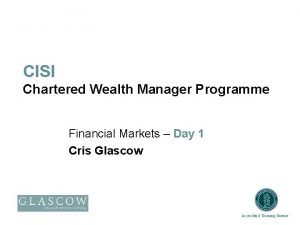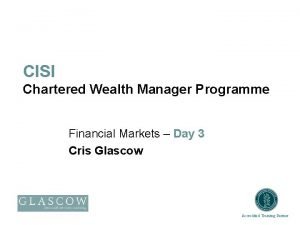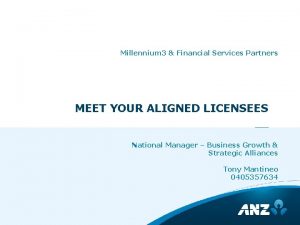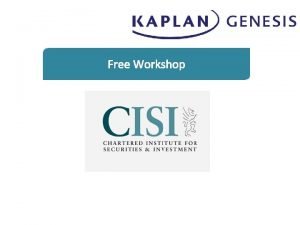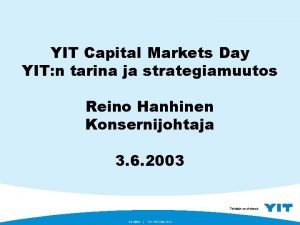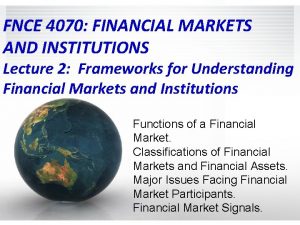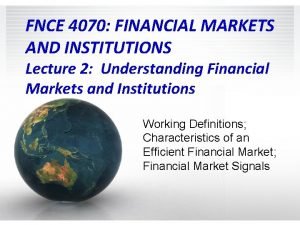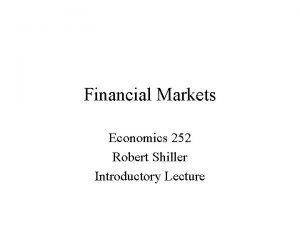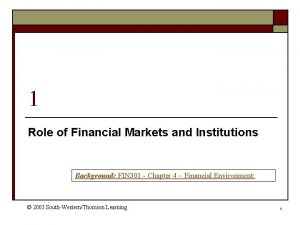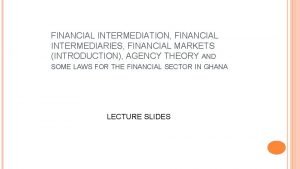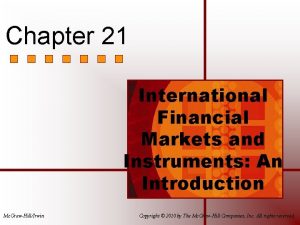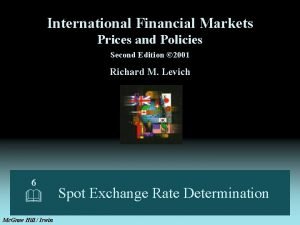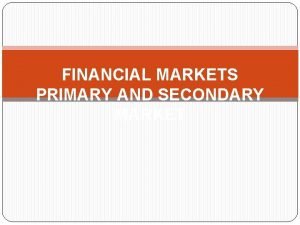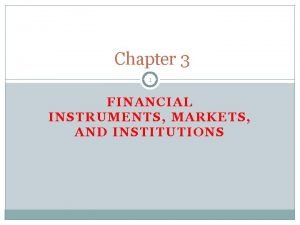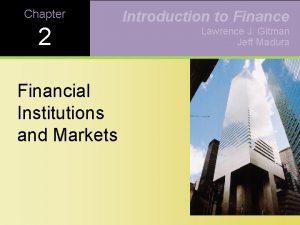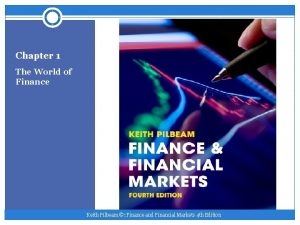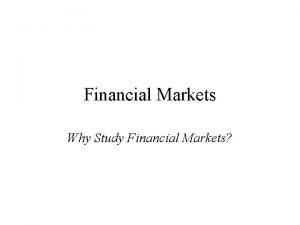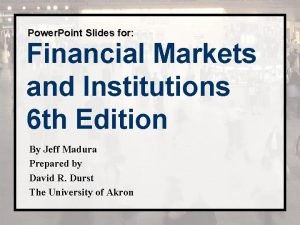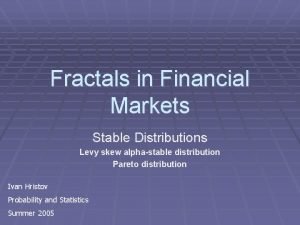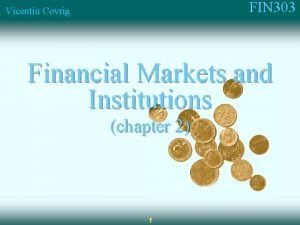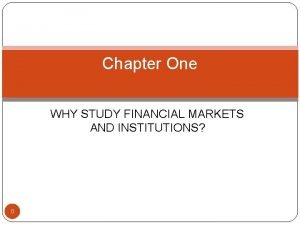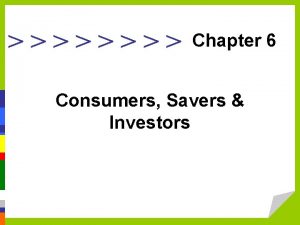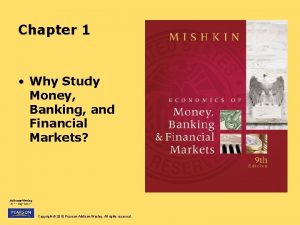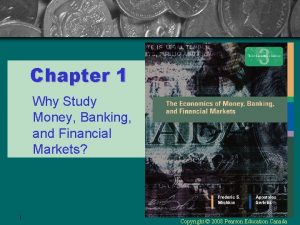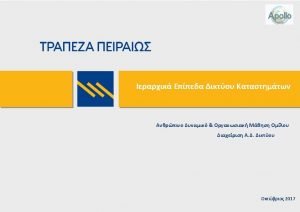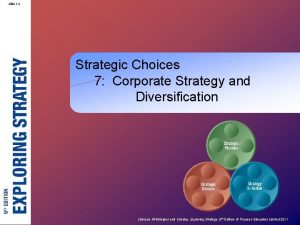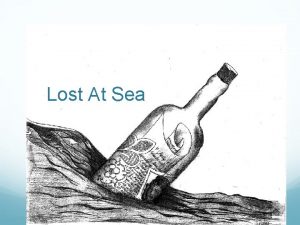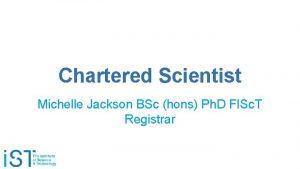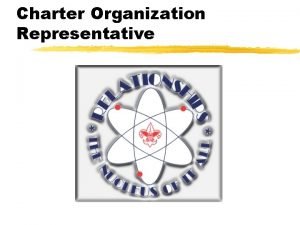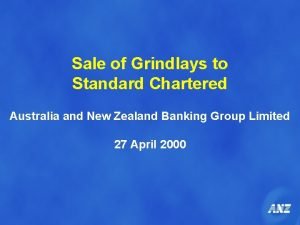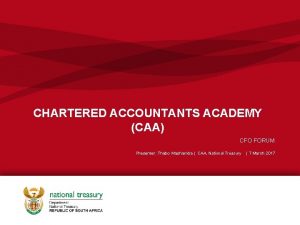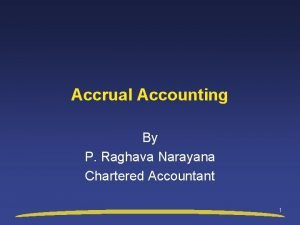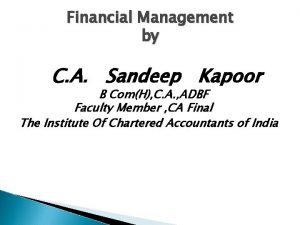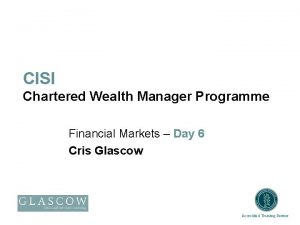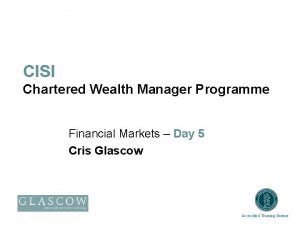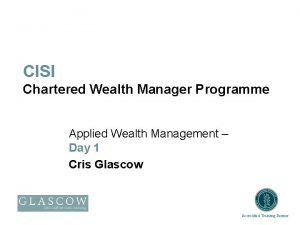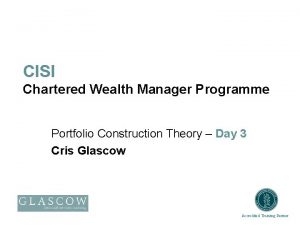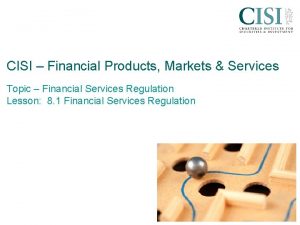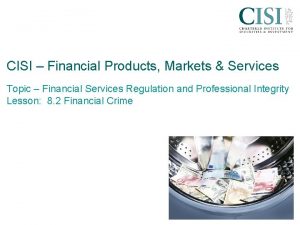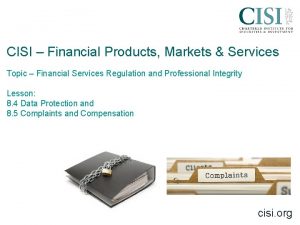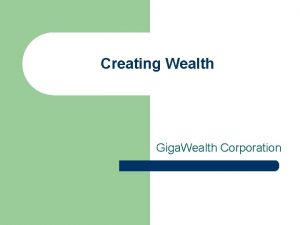CISI Chartered Wealth Manager Programme Financial Markets Day






























































- Slides: 62

CISI Chartered Wealth Manager Programme Financial Markets – Day 3 Cris Glascow Accredited Training Partner

Objectives By the end of the workshop you will have: q Revised relevant learning outcomes q Practised exam type questions q Identified areas you need to read about more thoroughly q Devised an action plan. Accredited Training Partner

Agenda q Mock test and Assignment review q Modules 5 and 6 Accredited Training Partner

Day 1 and 2 Mock Test and Assignments 1 and 2 – Review Module 5 – Cash Accredited Training Partner

Cash Deposits q Capital protection (note compensation scheme limits) q Inflation risk q Interest rate risk q Banks, building societies and NS&I. Reference: https: //www. nsandi-adviser. com/sites/nsandiadviser/files/asset/literature/quick-guide_3. pdf Accredited Training Partner

Annualised Rate of Interest q Account pays interest at an annual rate of 4. 8% q Interest is credited quarterly q 4. 8%/4 = 1. 2 will be paid quarterly The annualised rate is: [(1 + 0. 012)4 - 1] = 0. 0489 x 100 = 4. 89% (rounded). Accredited Training Partner

Tax Treatment of Cash Deposits q No capital gains tax q Interest taxed at 20%, 40% or 45% of gross interest Example: In 2018/19, Alex receives interest of £ 750. 00 from his building society account. He is a 45% tax payer. Calculate the additional tax he will have to pay on the interest via his self-assessment tax return. Accredited Training Partner

Cash NISA q Minimum age 16 q NISA limit is £ 20, 000 (2018/19) q Savings must be made by 5 April to apply to relevant tax year q Unused savings cannot be rolled over to a subsequent tax year Accredited Training Partner

Offshore Deposits q Interest credited gross. Level of tax due on interest then depends upon individual’s tax status measured by residency and domicile q Currency risk if not denominated in sterling q Default risk (depending upon the jurisdiction) q Political risk q Risk of financial crime e. g. money laundering. Accredited Training Partner

Effects of Inflation on Deposit Interest Example: Calculate the real returns of a deposit that generated 7% nominal over one year when inflation was at a rate of 5. 5% pa over the same period. Accredited Training Partner

Effects of Inflation Answer: Real return = (1 + Rnom) -------- - 1 (1 + Rinf) = (1. 07 / 1. 055) - 1 = 0. 01422 = 1. 422% (rounded) Accredited Training Partner

Money Markets q Short-term lending / borrowing typically up to 12 months q No centralised exchange q Benchmarking to LIBOR q Convention is to issue in bearer form q Often no coupon - discount to maturity value. Accredited Training Partner

Money Market Participants q Bank of England q Commercial banks q Companies q Institutions - e. g. pension funds, insurance companies, fund managers etc. q Deposit brokers. Accredited Training Partner

Money market instruments – Government instruments - Treasury Bills q q q Short-term loan instruments guaranteed by UK government 28 days, 91 days, 182 days or 364 days to redemption No coupon - issued at a discount to maturity value Issued by Debt Management Office (DMO) Can be held in CREST and Euroclear Competitive weekly tenders - min £ 500 k nominal. Above this in multiples of £ 50 k q Subsequent trading - minimum denomination is £ 25 k q Primary participants of competitive bids – banks. Reference: http: //www. dmo. gov. uk/index. aspx? page=About/TBills Accredited Training Partner

Calculating Yields on Treasury Bills Example: Yield = 100 - discounted value --------------------discounted value x Days / 365 e. g. 100 - 99 --------- = 0. 020258 or 2. 0258% 99 x 182/365 Accredited Training Partner

Repurchase Agreements q Borrower agrees to immediately sell security to lender and buy it back at a future fixed price later q Difference between forward price and spot price = interest q Legally binding agreements. Note Reverse Repos q Not just gilts used q Overnight market - mainly banks (note usage). Accredited Training Partner

Money Market Instruments Types of commercial instrument: q Commercial Paper q Euro Commercial Paper q Asset Backed Commercial Paper q Bills of Exchange (see next slide). Accredited Training Partner

Bills of Exchange Exercise In your groups, describe how a “bill of exchange” works and the steps involved. Where appropriate, use a diagram to assist your explanation. Accredited Training Partner

The Foreign Exchange Market q No central exchange - OTC q Dominated by banks - no formal market makers q Spot transactions - immediate deals settled in 2 working days q Forward transactions - agreed for a future date as an exchange rate fixed now. Accredited Training Partner

Forward Exchange Rates and Interest Rate Parity Example q Current spot rate: £ 1 for $1. 53 q Interest rates: 4% US, 4. 4% UK q In 1 year: $1. 53 x 1. 04 = $1. 5912. £ 1 x 1. 044 = £ 1. 044 q Forward rate should be based on $1. 5912/£ 1. 044 = $1. 5241 per £ 1. Accredited Training Partner

Foreign Exchange EXAM PRACTICE QUESTION – Briefly describe the key attributes to the following types of foreign exchange transaction: a) Non-deliverable forward b) Swap c) Option (5 marks). Accredited Training Partner

Module 6 – Bonds Accredited Training Partner

Fixed Interest Securities Basics Issuers Negotiable instruments Accredited Training Partner

Coupon frequency Semi-annual Coupon Zero coupon Annual Straights Stepped coupons Variable rates Spreads Difference between yield on one instrument against another Expressed in basis points Maturity date Single-dated Double-dated Callable Putable Irredeemable Convertible General Points Fixed Income Securities Stripped bonds All component parts of bond are stripped away Accredited Training Partner

Bonds and fixed income Characteristics – Gilts q Shorts - 7 years or less to run q Mediums – between 7 and 15 years until redemption q Longs - over 15 years to redemption. Accredited Training Partner

Bonds and fixed income – Sovereign and Government Bonds Gilts Issuance q DMO q Auctions – competitive, noncompetitive q Interim funding (TAPS) q GEMMs – obligations and privileges q Brokers - buy/sell as principal or agent q Gilt inter-dealer brokers – anonymous deals between GEMMs q Secondary market - role of GEMMs. Accredited Training Partner

Bonds and fixed income – Sovereign and Government Bonds Repurchase Agreements q Borrower agrees to immediately sell security to lender and buy it back at a future fixed price later q Difference between forward price and spot price = interest q Legally binding agreements q Not just gilts used q Reverse repo. Accredited Training Partner

Security Credit ratings e. g. S&P: Investment grade: AAA to BBB - Fixed charge Floating charge Unsecured Speculative grade: BB+ to BBHigh likelihood of bankruptcy: CCC to C Bankrupt or in default: D Markets Eurobond - bearer form Domestic - registered form Redemption Bullets - single date Sinker - proportion of issue is redeemed each year. Final payment known as balance or balloon Equity sweeteners Corporate Debt Convertibles - trade off with conventional bonds Warrants - can be split away from bond and traded separately Accredited Training Partner

Bonds and fixed income – Corporate debt - Markets for Trading Corporate Bonds New issues in the corporate bond market Issuer Lead Manager The Management Group Client Client Client Accredited Training Partner

Bonds and fixed income – Corporate debt - Markets for Secondary Trading in Corporate Bonds q The method of dealing in corporate bonds once issued, tends to be away from the major exchanges in a decentralised market. Dealers provide liquidity by their willingness to buy or sell bonds and effectively act as market makers. q Bond trading is either conducted between dealers or between dealers and their customers (e. g. asset managers). Dealer to dealer trading can occur in three ways: q. Direct telephone contact q. Indirect via an inter dealer broker voice broking the deal q. Via an electronic market known as an electronic trading platform such as MTS or Brokertec. Accredited Training Partner

Bonds and fixed income – Corporate debt - Markets for Secondary Trading in Eurobonds q In a currency other than that of the market in which they are issued q Trading mechanism is OTC q Issued in bearer form q Unsecured debt q No witholding tax q Coupons taxable but paid gross and annually q Held in depositaries e. g. Euroclear or Clearstram q ICMA q Settlement T + 2 q Accrued interest calculated 30 days per month and 360 days per year (30/360). Accredited Training Partner

Bonds and fixed income Present value and yield calculations - Corporate Bond Pricing Accredited Training Partner

Corporate Bond Pricing - semi annual Exercise Calculate the present value for a bond with the following features: q Coupon 2% q Desired yield 4% q Coupon payments 10, maturity in 5 years. Accredited Training Partner

Index-linked Bond Pricing - semi annual Exercise Calculate the present value for an index-linked bond with following features: q Coupon 4% q Desired yield 5% every six months q Coupon payments 6, maturity in 3 years q RPI at issue was 100 and RPI for last coupon was 160 q Inflation currently at 2% every 6 months and is expected to stay at this level. Accredited Training Partner

Bonds and fixed income Present value and yield calculations - Clean / Dirty Price - Accrued Interest Calculation (Cum div) Accrued interest to be added on to buyer’s cost Formula: Par Value x Coupon 2 x No. of days owned No. of days in period Accredited Training Partner

Bonds and fixed income Present value and yield calculations - Accrued Interest Calculation (Ex div) Accrued interest to be deducted from buyers cost Formula: Par Value x Coupon 2 x No. of days owned No. of days in period Accredited Training Partner

Bonds and fixed income Present value and yield calculations - Example dirty price Kevin bought £ 10, 000 nominal of Treasury 5% 2017 priced at 122. 50 on 6/12/93. He sold all the stock at 133. 60 for settlement on 17/3/08. Interest is paid on the 25 th August and 25 th February. (Note that there are 182 days in the half year relating to the sale and 21 days accrued interest at the sale settlement date). Calculate: The proceeds received at the sale date (excluding brokerage and other expenses). Accredited Training Partner

Bonds and fixed income Present value and yield calculations - Calculating Bond Returns q Yields establish the returns on a gilt q They enable investors to compare returns with other investments and make informed decisions q. Flat yield q. Japanese gross redemption yield q. Gross redemption yield q. Net redemption yield q. Grossed up net redemption yield. Accredited Training Partner

Bonds and fixed income Present value and yield calculations - Calculating Bond Returns – Flat Yield Annual Coupon (Gross) x 100 Market Price (Clean) Accredited Training Partner

Bonds and fixed income Present value and yield calculations - Calculating Bond Returns – Japanese Gross Redemption Yield Flat Yield + Profit (or Loss) to redemption / Number of years to redemption X 100 Market Price (Clean) Accredited Training Partner

Bonds and fixed income Present value and yield calculations - Gross Redemption Yield (GRY) q Effectively, IRR q Through interpolation, reasonably accurate GRY can be found q IRR can also be used for calculating net redemption yield. Accredited Training Partner

Bonds and fixed income Present value and yield calculations - Returns on Gilts – Net Redemption Yield Flat Yield x (100 - tax rate) % + Profit (or Loss) to redemption / Number of years to redemption X 100 Price (Clean) Accredited Training Partner

Evaluating Floating Rate Notes Example: If FRN is priced at £ 104. 20 six months into the annual coupon payment period, what is the GRY assuming interest rates were 5% at the last reset date? Accredited Training Partner

Evaluating Floating Rate Notes Answer: 104. 20 = 5 + 100 ------(1 + r) 1/2 5 + 100 = -----104. 20 (1 + r) = 1/2 √ 1. 0077 105 = ----104. 20 = 1. 0077 = 1. 0154 = 1. 54% Accredited Training Partner

Forward rates Forward Rate = (1 + r 1) x (1 + 1 f 2) = (1 + r 2)2 Where: r 1 and r 2 are the one and two year spot rates and 1 f 2 is the forward rate from Time 1 to Time 2. Handout 1 – Example Accredited Training Partner

Yield Curve Normal – Upward Sloping Yield Curve Gross Redemption Yield x x x x Time to Maturity (Years) Accredited Training Partner

Theories relating to the Yield Curve shape q. Liquidity Preference Theory q. Pure Expectations Theory q. Segmentation / Preferred Habitat Theory. Accredited Training Partner

Bonds and fixed income Risks q Interest rate q Inflation q Default q Liquidity q Political q Issue specific q Fiscal. Accredited Training Partner

Bond Sensitivities q Low coupon q Low yield q Long time to maturity. Accredited Training Partner

Macaulay Duration and its Determinants What is Macaulay Duration? q The economic life of a bond i. e. , how long (in years), it takes for the price (cost) of a bond to be repaid by its cash-flows (coupons / redemption value) q The elasticity of a bond’s price in relation to interest rates. Accredited Training Partner

Duration – The Determinants q The coupon rate q The higher the coupon, the lower the duration q The time to maturity q The longer to maturity, the higher the duration q The yield q The higher the yield, the lower the duration Accredited Training Partner

Calculation of Macaulay Duration Bond price £ 100. 00 Yield to maturity (YTM) 7. 0% Face value £ 100. 00 Coupon frequency 1 Coupon rate 6. 00% Life in years 5 Period Cash Flow PV Cash Flow Duration calculation Cash Flow/ [(1 + YTM/Coupon Frequency)^Period] PV Cash Flow * Period 1 £ 6. 00 £ 5. 61 2 £ 6. 00 £ 5. 24 £ 10. 48 3 £ 6. 00 £ 4. 90 £ 14. 70 4 £ 6. 00 £ 4. 57 £ 18. 28 5 £ 106. 00 £ 75. 58 £ 377. 90 TOTALS £ 95. 90 £ 426. 97 Macaulay Duration £ 426. 97 / £ 95. 90 4. 452 Accredited Training Partner

Modified Duration Formula Modified Duration = Macaulay Duration (1 + yield) Gives an approximation. How much will a bond’s price move for a % change in yield. Accredited Training Partner

Convexity * * Convexity Error Price Handout 2 – Example Actual Price * Predicted Price Yield Accredited Training Partner

Day 3 Review q Review slides and exercises against syllabus q Check areas of understanding questions for next session q Assess past exam reports for questions on syllabus areas covered. Accredited Training Partner

ANSWERS Accredited Training Partner

Tax treatment of cash deposits Answer: £ 750. 00. Further tax at £ 750. 00 x 45% = £ 337. 50 Accredited Training Partner

Bills of Exchange Accepting bank 2. Fee 2. Accepted Bill with guarantee 1. Bill of exchange - IOU Customer Supplier 1. Goods 4. Presents bill 4. Pays £ 500 Financial intermediary 3. Discounts 3. Pays discount e. g. £ 490 Accredited Training Partner

Answer: - Semi-annual coupon Accredited Training Partner

Answer: - Index linked semi-annual coupon Accredited Training Partner

Answer – dirty price Consideration on sale = £ 10, 000 x 1. 3360 = £ 13, 360 Accrued interest = £ 10, 000 x 5% x 0. 5 x 21/182 = £ 28. 85 Proceeds = £ 13, 360 + £ 28. 85 = £ 13, 388. 85 Accredited Training Partner

Answer – dirty price – index linked Price (per £ 100 nominal) = £ 117. 76 x 1. 29897 = £ 152. 97 Accrued interest = £ 100 x 1. 25% x 0. 5 x 112 / 181 x 1. 29897 = £ 0. 50 Dirty Price = £ 152. 97 + £ 0. 50 = £ 153. 47 Accredited Training Partner
 Cisi chartered wealth manager
Cisi chartered wealth manager Cisi discount code
Cisi discount code Chartered wealth manager cisi
Chartered wealth manager cisi Day 1 day 2 day 3 day 4
Day 1 day 2 day 3 day 4 Day 1 day 2 day 817
Day 1 day 2 day 817 Millennium 3 financial services reviews
Millennium 3 financial services reviews Cisi introduction to securities and investment
Cisi introduction to securities and investment Cisi or cfa
Cisi or cfa Metsä board osinko
Metsä board osinko Why study financial markets
Why study financial markets Financial markets and institutions jeff madura ppt
Financial markets and institutions jeff madura ppt Classification of financial markets
Classification of financial markets Financial market classification
Financial market classification Robert shiller financial markets
Robert shiller financial markets Classification of financial markets
Classification of financial markets Classification of financial markets
Classification of financial markets Primary vs secondary financial markets
Primary vs secondary financial markets Financial intermediaries ppt
Financial intermediaries ppt Financial intermediary
Financial intermediary Are financial markets efficient
Are financial markets efficient International financial markets and instruments
International financial markets and instruments Capital markets and financial intermediation
Capital markets and financial intermediation Levich international financial markets
Levich international financial markets Levich international financial markets
Levich international financial markets Secondary financial markets
Secondary financial markets Efficient capital allocation
Efficient capital allocation Types of exchange rate
Types of exchange rate Financial markets instruments and institutions
Financial markets instruments and institutions Madura j. financial markets and institutions
Madura j. financial markets and institutions Pilbeam k. finance and financial markets
Pilbeam k. finance and financial markets Keith pilbeam
Keith pilbeam Classification of financial markets
Classification of financial markets Madura j. financial markets and institutions
Madura j. financial markets and institutions Fractals in financial markets
Fractals in financial markets Well functioning financial markets
Well functioning financial markets Why study financial markets and institutions
Why study financial markets and institutions Savers and investors role in financial markets
Savers and investors role in financial markets Why study money banking and financial markets
Why study money banking and financial markets Why study money banking and financial markets
Why study money banking and financial markets Why study financial markets
Why study financial markets Mdm kerala
Mdm kerala Senior manager vs general manager
Senior manager vs general manager Portfolio manager synergy manager parental developer
Portfolio manager synergy manager parental developer The hong kong institute of chartered secretaries
The hong kong institute of chartered secretaries Ciwem membership
Ciwem membership Peter rosenwald
Peter rosenwald Lost at sea activity answers
Lost at sea activity answers Initial professional development
Initial professional development Chartered geologist
Chartered geologist Chartered scientist
Chartered scientist Mbcs membership
Mbcs membership What is a chartered organization
What is a chartered organization Standard chartered australia
Standard chartered australia Chartered secretaries southern africa
Chartered secretaries southern africa Chartered project professional
Chartered project professional Institute of chartered secretaries and administrators
Institute of chartered secretaries and administrators International professional engineer
International professional engineer Cipd assessment examples
Cipd assessment examples Property valuation certificate by chartered accountant
Property valuation certificate by chartered accountant Chartered accountants academy
Chartered accountants academy Accrue chartered accountants
Accrue chartered accountants Emerging role of financial manager in india
Emerging role of financial manager in india Certified defense financial manager
Certified defense financial manager
